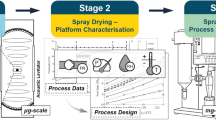Abstract
The feasibility of spray-drying solutions of recombinant methionyl human growth hormone (hGH) and tissue-type plasminogen activator (t-PA) was investigated. hGH was formulated in a mannitol phosphate buffer and t-PA was used in an arginine phosphate formulation containing 0.004% (w/v) polysorbate 80. Using filtered air (90 – 150°C) as the drying medium, hGH could be dried to a residual moisture content of ≤4%. However, approximately 25% of the protein was degraded during the processing. Results of atomization studies suggest that surface denaturation at the air–liquid interface of the droplets in the spray plays a major role in the degradation of the protein. The addition of 0.1% (w/v) polysorbate 20 into the hGH formulation reduced the formation of soluble and insoluble aggregates by approximately 90% during atomization. During spray-drying the addition of 0.1% (w/v) polysorbate 20 reduced the formation of soluble and insoluble aggregates by approximately 70 and 85%, respectively. In contrast, t-PA remained intact upon atomization. Depending on the spray-drying conditions, product powders with a residual moisture content between 5 and 8% were obtained. No oxidation, aggregation, or denaturation occurred in the protein under several operation conditions. Overall, this study demonstrates that it is feasible to spray-dry t-PA in the current marketed formulation.
Similar content being viewed by others
REFERENCES
Y. C. Wang and M. A. Hanson. Parenteral formulations of proteins and peptides: Stability and stabilizers. J. Parent. Sci. Technol. 42:S3–26 (1988).
M. C. Manning, K. Patel, and R. T. Borchardt. Stability of protein pharmaceuticals. Pharm. Res. 6 (11):903–918 (1989).
A. P. MacKenzie. Freeze-drying of aqueous solutions containing peptides and proteins. In D. Marshak and D. Liu (eds.), Therapeutic Peptides and Proteins: Formulation, Delivery, and Targeting, Cold Spring Harbor, New York, 1989, pp 17–21.
M. J. Pikal. Freeze-drying of proteins. I. Process design. Bio Pharm 3 (8): 18–27 (1990); II. Formulation selection. BioPharm 3(9): 26–30 (1990).
G. Taborski. Protein alterations at low temperature: An overview. In O. Fennema (ed.), Proteins at Low Temperatures, American Chemical Society, Washington, D.C., 1979, pp. 1–26.
F. Franks. Cryobiochemistry—Responses of proteins to suboptimal temperatures. In F. Franks (ed.), Biophysics and Biochemistry at Low Temperatures, Cambridge University Press, Cambridge, 1985, pp. 62–89.
L. van den Berg and D. Rose. Effect of freezing on the pH and composition of sodium and potassium phosphate solutions: The reciprocal system KH2PO4 · Na2HPO4 · H2O. Arch. Biochem. Biophys. 81:319–329 (1959).
P. L. Schwartz and M. Batt. Aggregation of iodine-125 labeled human growth hormone in response to freezing and thawing. Endocrinology 92 (6):1795–1798 (1973).
T. Koseki, N. Kitabatake, and E. Doi. Freezing denaturation of ovalbumin at acid pH. J. Biochem. 107:389–394 (1990).
L. Randen, J. Nilson, and P. Edman. Coprecipitation of enzymes with water soluble starch—An alternative to freezedrying. J. Pharm. Pharmacol. 40:763–766 (1988).
J. F. Carpenter, B. Martin, L. M. Crowe, and J. H. Crowe. Stabilization of phosphofructokinase during air-drying with sugars and sugar/transition metal mixtures. Cryobiology 24:455–464 (1987).
B. Roser. Trehalose-drying: A novel replacement for freezedrying. BioPharm 3 (9):47–53 (1991).
F. Franks, R. H. M. Hatley, and S. F. Mathias. Materials science and the production of shelf-stable biologicals. BioPharm 3 (10):38–55 (1991).
K. Masters. Applications of spray-drying, in food industry, in pharmaceutical-biochemical industry. In Spray-Drying Handbook (5th ed.), Longman Scientific and Technical, Essex, U.K., 1991, pp. 491–676.
J. Broadhead, S. K. Edmond Rouan, and C. T. Rhodes. The spray-drying of pharmaceuticals. Drug Dev. Ind. Pharm. 18(11&12):1169–1206 (1992).
P. L. Privalov. Stability of proteins: small globular proteins. Adv. Protein Chem. 33:167–241 (1979).
A. Klibanov. Stabilization of enzymes against thermal inactivation. Adv. Appl. Microbiol. 29:1–28 (1983).
J. J. Sedmak and S. E. Grossberg. Interferon stabilization and enhancement by rare earth salts. J. Gen. Virol. 52:195–198 (1981).
P. Labrude, M. Rasolomanana, C. Vigneron, C. Thirion, and B. Chaillot. Protective effect of sucrose on spray-drying of oxyhemoglobin. J. Pharm. Sci. 78 (3):223–229 (1989).
Protropin-Somatrem for injection. In Physicians' Desk Reference, 46th ed., Medical Economics Data, NJ, 1992, pp. 1049–1050.
Activase-Alteplase Recombinant. In Physicians' Desk Reference, 46th ed., Medical Economics Data, NJ, 1992, pp. 1047–1049.
W. J. Kohr, R. Keck, and R. N. Harkins. Characterization of intact and trypsin-digested biosynthetic human growth hormone by high pressure liquid chromatography. Anal. Biochem. 122:348–359 (1982).
G. A. Vehar, M. W. Spellman, B. A. Keyt, C. K. Ferguson, R. G. Keck, R. C. Chloupek, R. Harris, W. F. Bennet, S. E. Builder, and W. S. Hancock. Characterization studies of human tissue-type plasminogen activator produced by recombinant DNA technology. Cold Spring Harb. Symp. Quant. Biol. 51:551–562 (1986).
M. W. Spellman, L. J. Basa, C. K. Leonard, J. A. Chakel, J. V. O'Connor, S. Wilson, and H. van Halbeek. Carbohydrate structures of human tissue plasminogen activator expressed in Chinese hamster ovary cells. J. Biol. Chem. 264:14100–14111 (1989).
E. Bagnoli, F. H. Fuller, V. J. Johnson, and R. W. Norris. Psychrometry. In Chemical Engineers' Handbook, 5th ed., R. H. Perry and C. H. Chilton (eds.), McGraw-Hill, New York, 1985, pp. 12.2–12.4.
B. M. Eckhardt, J. Q. Oeswein, and T. Bewley. Effect of freezing on aggregation of human growth hormone. Pharm. Res. 8:1360–1364 (1991).
R. H. Carlson, R. L. Garnick, A. J. Jones, and A. M. Meunier. The determination of recombinant human tissue-type plasminogen activator by turbidimetry using a microcentrifugal analyzer. Anal. Biochem. 168:428–435 (1988).
K. Masters. Evaporation of droplets containing dissolved solids. In Spray-Drying Handbook, 5th ed., Longman Scientific and Technical, Essex, U.K., 1991, pp. 329–330.
K. Masters. Understanding and applying spray-dryers in chemical processing. Powder Bulk Eng. Apr:36–44 (1990).
J. Q. Oeswein and J. Patton. Aerosolization of proteins. Presented at Respiratory Drug Delivery II, Keystone, CO, March (1990).
T. A. Bewley and J. T. Yang. Measurement of chiroptical phenomena in proteins. In C. H. Li (ed.), Hormonal Proteins and Peptides, Academic Press, 1980, Vol. IX, pp. 175–238.
Author information
Authors and Affiliations
Rights and permissions
About this article
Cite this article
Mumenthaler, M., Hsu, C.C. & Pearlman, R. Feasibility Study on Spray-Drying Protein Pharmaceuticals: Recombinant Human Growth Hormone and Tissue-Type Plasminogen Activator. Pharm Res 11, 12–20 (1994). https://doi.org/10.1023/A:1018929224005
Issue Date:
DOI: https://doi.org/10.1023/A:1018929224005




